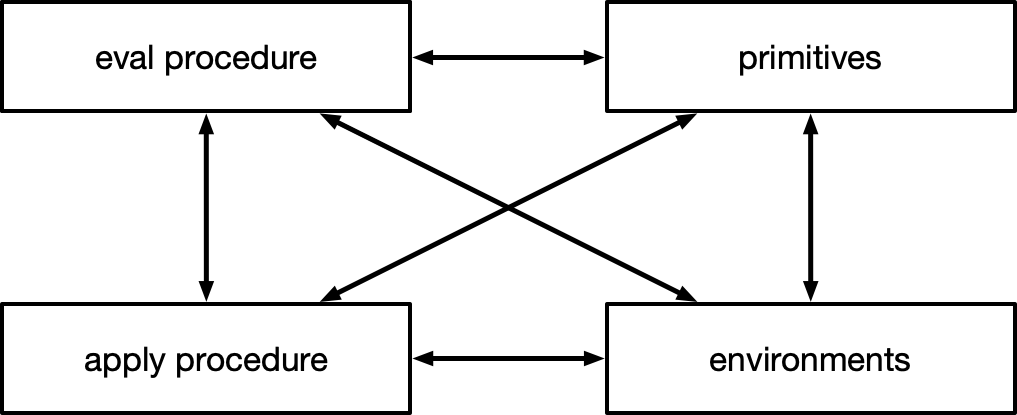Higher-Order Programming » Lab Sessions
Session 8
Assistant: Steven Keuchel (steven.keuchel@vub.be)
Section 1: Understanding The Metacircular Scheme evaluator
Download the metacircular implementation and open this file in DrRacket. In contrast to previous exercises that required you to make use of a file, you will need to make direct changes to this file. So be sure to keep a copy of the original file in case you wish to revert your changes.
In the implementation of the metacircular evaluator we redefine apply, which
is not allowed by default in the R5RS implementation bundled with Racket. You
may have to configure DrRacket to allow this redefinition. See the instructions
from the first lab session.
Be sure to uncheck "Disallow redefinition of initial bindings"!
The foundations
The metacircular implementation can be difficult to understand, since multiple components are inherently dependent on each other. The figure below showcases the four important components.

The eval procedure
This procedure dispatches over the different types of expressions. After an expression has been entered in the REPL, it will be sent to this procedure for further evaluation. There are multiple branches here, and every branch represents one type of expression.
If you want to add new special forms (syntax), you have to add them to this condtional.
The apply procedure
This procedure is executed when the expression in eval is an application (it
is a list). eval already evaluated both the operator expression and the
argument expressions, therefore apply receives the procedure object (or
something that is not a procedure: and therefore should raise an error) and a
list of argument values.
Ignoring the error case, there are two options. Either a primitive procedure needs to be applied (a procedure that is given by the language implementation itself), or a user-defined (compound) procedure that is implemented by the user of the metacircular evaluator.
In the latter case, the body of the procedure is evaluated in the lexical scope that is created by extending the environment of the procedure object with the bindings that bind the formal parameters to the actual values.
The duality of eval and apply

The two most important componenets of the metacircular evaluator are eval and
apply. We also need primitives and environments as part of a working language,
but the heart of the implementation can be found in only eval and apply. The
difference between eval and apply is...
evaltakes an expression and an environment as input, and callsapply(when appropriate) with a procedure value, and a list of arguments.applytakes a procedure and arguments, and callsevalwith an expression (the body of the procedure), and an environment (the extended environment)
Primitives
Primitive procedures are the foundation blocks on which new programs can be build. A Scheme evaluator by default comes with many primitives. For simplicity, only the most important ones are supplied in our metacircular implementation.
The variable primitive-procedures contains a list of all built in procedures. Each element of this list is a list of size 2, where the first element is the name (as a symbol) of the procedure: this is how it will be available in the global environment. The second element is the procedure object itself. In this metacircular Scheme evaluator the built-in procedure itself is made available.
Next to primitive operations there are special forms. Remember that the eval procedure dispatched over the different types of expressions. The main difference between procedures and special forms in the metacircular evaluator is that special forms work on expressions, and procedures work on evaluated expressions (i.e., values).
During the exercises we will delve in both procedures and special forms.
Environments
The last important component of the metacircular Scheme evaluator are environments. An environment can be seen as pair containing a frame, and a base environment. A frame is the combination of two lists: a list of variable names and a list of values that represents the bindings.
Every environment has an enclosing environment, except for the global environment which is the empty environment. Check the implementation of lookup-variable-value, set-variable-value!, and define-variable! for how special forms like define and set! operate, and how variables are resolved to their values.
Section 2: Primitive Procedures
In these exercises we are going to work on the metacircular implementation of Scheme in the Scheme implementation Racket. Remember that an evaluator is just a procedure (i.e. lambda) that when applied to an expression, performs the required actions to evaluate that expression. In other words, an evaluator is just another program. If we implement an evaluator in the same programming language for which we write an eval- uator, we call this a metacircular evaluator. Since a Scheme expression is actually just a list, a Scheme evaluator is nothing more than a list processing program.
Exercise 1: Division by Zero
Currently, the / procedure in the metacircular evaluator will make use of the
/ procedure from the host environment. Since that procedure raises an error
when the divisor is equal to the number zero, the metacircular evaluator will
stop working due to this error.
Instead of catching errors from the host environment in the metacircular
evaluator, you will modify the / procedure in the metacircular evaluator such
that it returns the number zero instead[^divisionbyzero]. Therefore, you get the
following behaviour in your modified metacircular evaluator.
[^divisionbyzero]: This is not entirely correct as it should return NaN (not a
number). However, this value is not available in Scheme. Therefore, if you
want to be correct, you can also choose to return 'nan (as a symbol)
instead, or +inf.0 or -inf.0 to represent an infinite value (depending
on the sign of the dividend).
Section 2: Syntactic Sugar
Exercise 2: Implementing when
Before delving in how special forms can be implemented we will explore how new syntactic constructs can be created by using syntactic sugar: by expanding a Scheme expression from one form, into another.
Currently, when you want to execute multiple expressions when a condition is
true, you have to wrap all expressions in a begin, even when there is no
"alternative" branch.
Wouldn't it be better if this program could be written as follows.
Hint! Just as before, it can help to create accessor procedures that make it
easier to retrieve values stored in the when expression: the condition, and
the expression sequence stored within. Remember that code is data!
Expand (eval exp env) with a case that when it encounters a when, it will
transform this expression to the corresponding program using only if and
begin, and then apply eval on this transformed program.
Hint! Check how cond is supported in the current implementation for an
example.
Hint! If you wish to check a part of your implementation, without starting
the metacircular REPL you can uncomment (driver-loop) at the bottom of the
file!
Exercise 3: Implementing let
Do the same thing for adding support for the let syntax: remember that for
each well-formed let expression, an equivalent expression using lambda can
be written (refer to earlier exercises that used this property). Make use of the
same technique as in the previous exercise.
Hint! Just as before, it can help to create accessor procedures that make it
easier to retrieve values stored in the let expression.
- Create the accessor procedures: (
let-body,let-clauses,let-clause-name,let-clause-expression). - Create a lambda expression where the formal parameters are the
let-clause-names of the clauses, and the body is thelet-body - Create an application expression where the procedure is the one created in
the previous step, and the arguments are the
let-clause-expressions of the clauses.
Section 3: Special Forms
After adding new syntactical constructs to our Scheme evaluator by transforming one
expression into another, we will look at how they can be implemented directly
without transforming their program text to an equivalent program text using
lower constructs (such as lambda, instead of let).
Exercise 4: Implementing when
Repeat exercise 3, this time by implementing the behaviour of when manually.
It should...
- First evaluate the boolean expression
- After it has been evaluated, its value should be checked.
- If it is true: evaluate the expression sequence
- Otherwise: do nothing
Hint! Start by looking at the evaluation of if, and adapt. The value
returned by when when the conditional expression returned false is
unspecified.
Exercise 5: Implementing let
Repeat the same for adding support for let.
It should...
- Evaluate for every clause the expression stored
- Create a new environment containing the bindings necessary in the let
- Evaluate the expression sequence in the extended environment.
- Return the result of evaluating the expression sequence
Hint! You can reuse the syntactical accessors from exercise 4.